There are several modern techniques to filter impure water. Reverse Osmosis (RO) is one of them. It is a water purification process that helps in removing contaminants and impurities from unfiltered water. In this technique, a semi-permeable membrane is used with the objective of removing undesired molecules, ions and different kinds of particles that make the water impure and unfit for any kind of consumption.
Table of Contents
Here Is The List Of The Best Reverse Osmosis Systems With Our Expert Review:
1. SimPure Tankless UV Reverse Osmosis Drinking Water Filter
The SimPure T1-400 Tankless RO system is tested and certified by SGS. With PP+CTO+T33+RO+UV 5 stages water filtration, it can remove up to 99.99% of Chlorides, Chemicals, Lead, Hydrogen Sulfide, fluoride, Chloramines, Heavy metals, PFAS, TDS, Pharmaceuticals, Microplastics, Viruses, Bacteria, and 1,000+ of other contaminants. This tankless RO system is also a BPA and Lead-free under-cabinet reverse osmosis system.
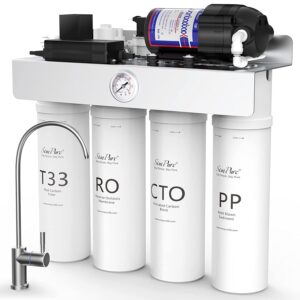
With the exclusive technologies, SimPure T1-400 is the highest TDS removal rate in the market. The TDS of tap water ≤ 200 PPM, and the filtered water TDS value will be 0 TDS. When 200-500 PPM, the removal rate is at least 95%, max to 99.99%. In addition, the UV filter addon provides an extra layer of protection against bacteria and viruses, with a removal rate up to 99.99%, ensuring the water is safe to drink.
Besides, it features a compact design that saves space and offers a continuous supply of purified water without needing a storage tank. The system also boasts quick and easy installation, low maintenance. The water pressure gauge alerts users when it’s time to replace the filters.
In conclusion, it is suitable for different uses with its unbelievable efficiency-400 GPD high flow rate and equipped with a boost pump, 1.5:1 low pure-to-drain ratio, and saves water waste by 400%. Whether you plan to purify water for whole-house drinking water, commercial business use, or small industrial use, SimPure T1-400 tankless RO water filter system is your first choice!
Pros And Cons: SimPure Tankless UV Reverse Osmosis Drinking Water Filter
Pros:
- Tankless Design
- TDS near 0, Removal Rate max to 99.99%
- UV Sterilization 99.99%
- 400 GPD Fast Water Flow Rat
- 1.5:1 low pure-to-drain ratio
- Easy to install
- 2-Year Registered Warranty
- Customer Service Support Based in US
Cons:
- Need electricity supply
2. APEC Top Tier 6-Stage Ultra Safe Reverse Osmosis Drinking Water Filter
One of the first things that catch your attention about this water filter is its fine build. The filters are extremely strong and known to last for years. The entire structure of the filter is assembled under the guidance of technical experts. It has been tested and certified by the Water Quality Association (WQA) and guarantees 99% accuracy when it comes to removing contaminants in the water.

You will come across several high-end water filters in the market which offer a large number of attractive features. APEC Ultra Safe water filter does not make any fancy claims. It is enabled with the kind of filtration technique that works towards providing safe and clean water for your cooking and drinking needs. It is capable of removing metal based particles that might be lurking somewhere within the water.
Despite comprising a multiple-filter based setup, it is quite light-weight and boasts of a compact design. An interesting feature of this water filter is that it runs even in the absence of electricity. It is made of super-capacity cartridges which put aside any concern you might have about maintaining it. It has the capacity to deliver 90 gallons of filtered water every day. The water that is delivered tastes good and is as healthy as you expect from a bottled mineral water.
PROS and Cons: APEC Top Tier 6-Stage Ultra Safe Reverse Osmosis Drinking Water Filter
3. iSpring RCC7AK 6-Stage Water Filter System
The iSpring 6-Stage water filter features a re-mineralization filter which happens to be one of its biggest selling point. When you purify the water through the reverse osmosis process, there is a possibility of the resultant water having a slightly bland flavor. This happens because the water, at times, becomes a little acidic owing to the removal of certain minerals during the reverse osmosis process.
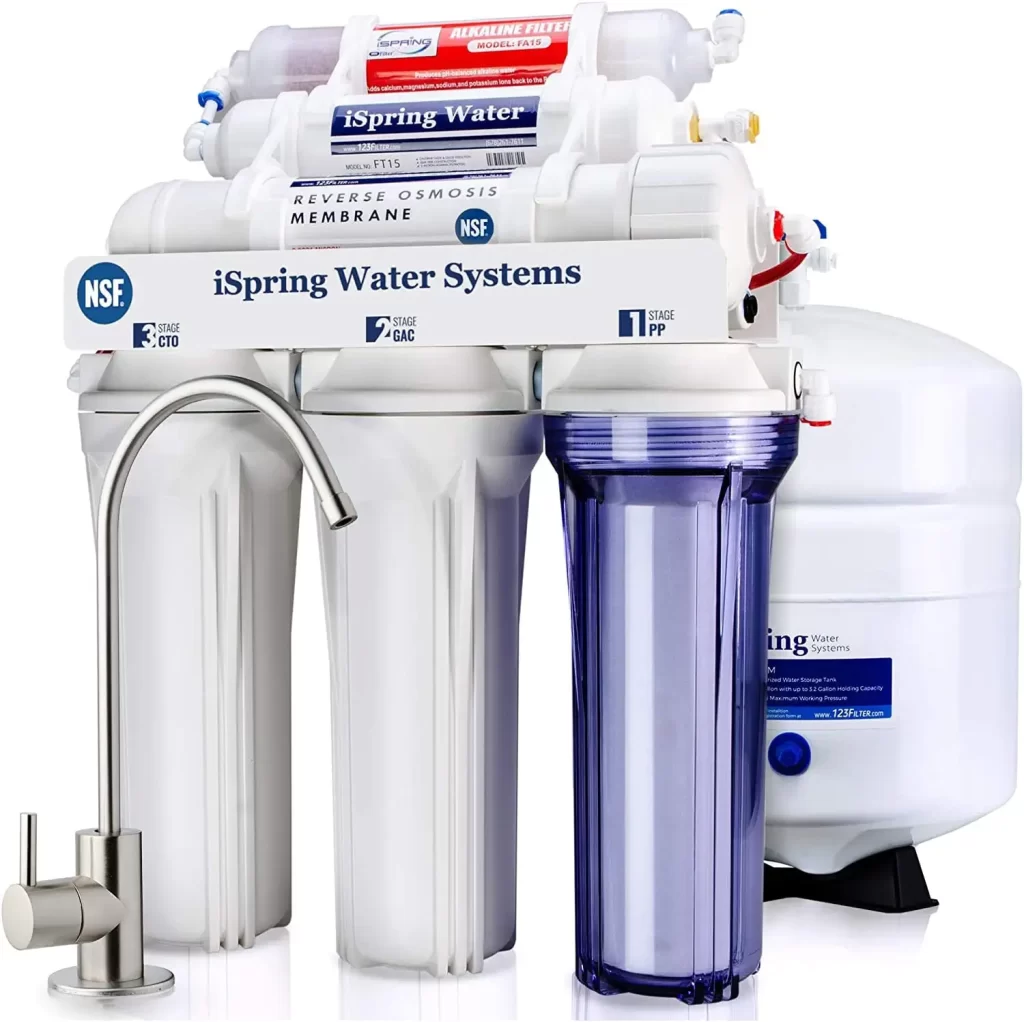
The re-mineralization filter which this device comes equipped with adds those minerals back in the water and increases the pH level so that the natural alkalinity of the water is restored. By doing this, it ensures that you are not deprived of any essential minerals while consuming the water. The filter system boasts of a very appealing design reminiscent of the European style faucet. Its mechanisms are designed in a way that a user would find it extremely easy to install after purchasing it.
You will get all the essentials that you need to install it in the kit the water filter arrives in. It consumes as much space as a regular water filter system and can be set up under or closer to a standard kitchen sink. You would not need any threading pipes during the installation process. The device passes through six different stages of filtration and is capable of producing 75 gallons of filtered water on a daily basis. You get a pressurized storage tank and a faucet along with the filters.
PROS and Cons:iSpring RCC7AK 6-Stage Water Filter System
4. Waterdrop RO Reverse Osmosis Drinking Water Filtration System
If you are looking for a tankless reverse osmosis water filtration system that would provide you clean drinking water as and when you need it, this would be a good investment for you. With one of the best processed-water to waste-water ratio (1:1), it is a great device for those who are particular about not wasting water. It is compact in size and boasts of a slim design which makes it an ideal fit for small-sized kitchen areas. The water in the filters goes through seven stages of filtration before it reaches the user.
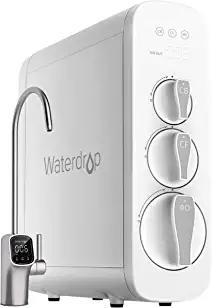
The water filter features a smart pressure pump which helps in detecting the incoming water pressure and adjusts it appropriately to achieve the fastest possible reverse osmosis process. While installing it in the kitchen, you would greatly benefit from the lead-free faucet that you get as a part of the package. There is an LED light in the faucet which gets switched on automatically when you use the faucet. It is built with brass and has a chrome plate on the exterior which ensures that the water flowing inside does not face any risk of contamination.
The carbon block filter contributes towards removing large-sized waste particles like sand, salt, chlorine and rust from the water. The reverse osmosis filter found in this device is much bigger and is, therefore, more effective than the one you would find in regular devices. It is 15 inches long and 4.3 inches wide. To prevent the accumulation of contaminants, the filters flush out a small amount of water 20 seconds after the filter has been used for 2 hours.
PROS And Cons: Waterdrop RO Reverse Osmosis
5. Home Master TMAFC-ERP Undersink Reverse Osmosis Water Filter System
Most RO filters follow a filtration process in which the water is purified by extracting all the minerals out of it. This in turn makes the water very acidic and bereft of any taste. The Home Master undersink water filter system not only purifies water effectively but also adds magnesium and calcium to the mix to lend an appealing flavor to the water. This filtration system is known to clean up around 98% of the contaminants present in the water.
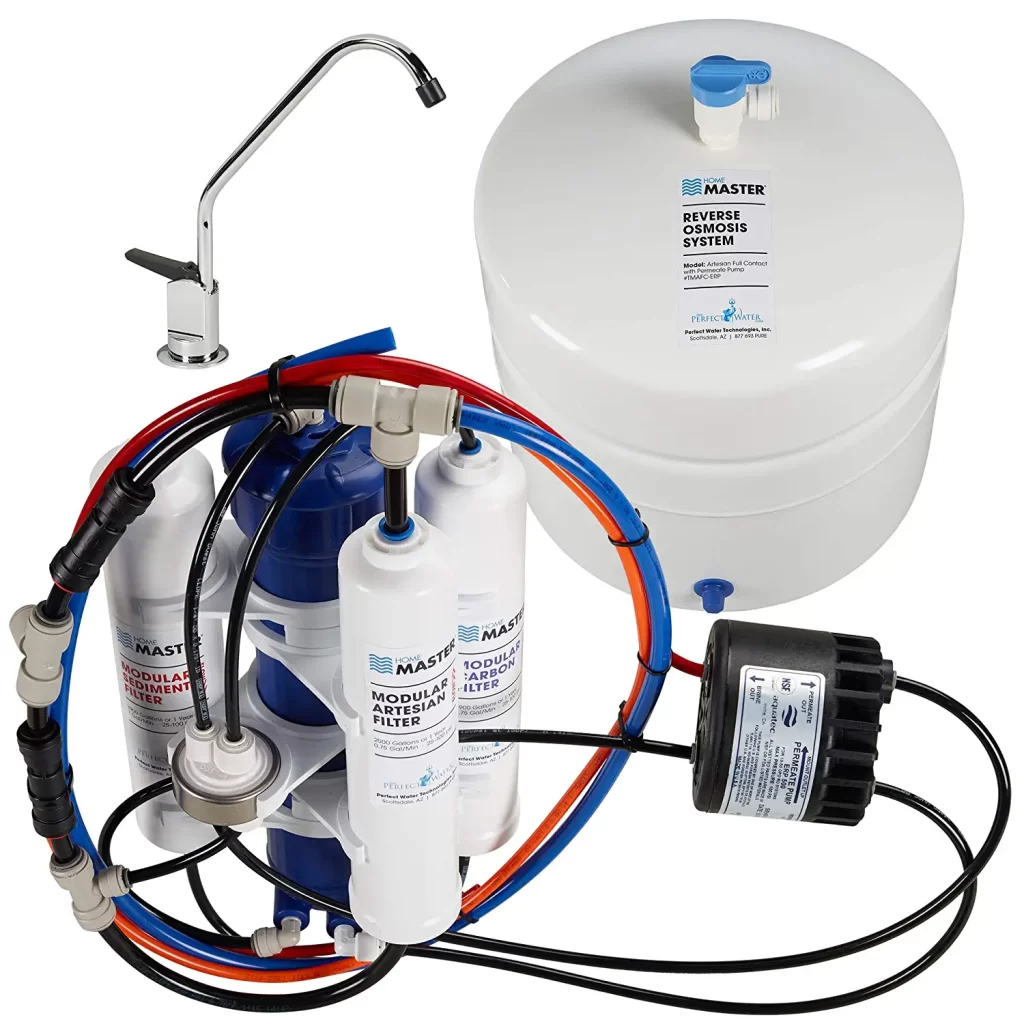
The purification process it undertakes has as many as seven stages which result in the delivery of crystal clear water. The filter has the capacity of producing 75 gallons of filtered water every day. It is an ideal buy for an office based setup or for people living in large families. If you are particular about the taste of the water you consume, here is the most appropriate water filter for you. It re-mineralizes water not just once but twice to make sure that all the beneficial minerals remain in the water that is delivered as final output.
The processed water is kept in a 3.2 gallon tank. To consume water, you just need to switch on the faucet. The water will start flowing out of the tank and pass through the final stage of purification quickly before it comes out of the machine. It takes a little less time to set up the filtration system. The manual has all the steps explained in detail. If you follow it carefully, you can get it installed without anybody’s help.
PROS And Cons: Home Master TMAFC-ERP Undersink Reverse Osmosis
6. APEC ROES-PH75 6-Stage Reverse Osmosis System
If you are looking for a highly advanced RO system but are on a budget, then the APEC ROES-PH75 water filter is a device you must check out. It is quite compact and can fit in easily in a small-sized kitchen. The installation process is very easy and you can set it up in less than an hour. The package comes with all that you will require for the installation process. Having a screwdriver and a drill at your disposal would be useful.
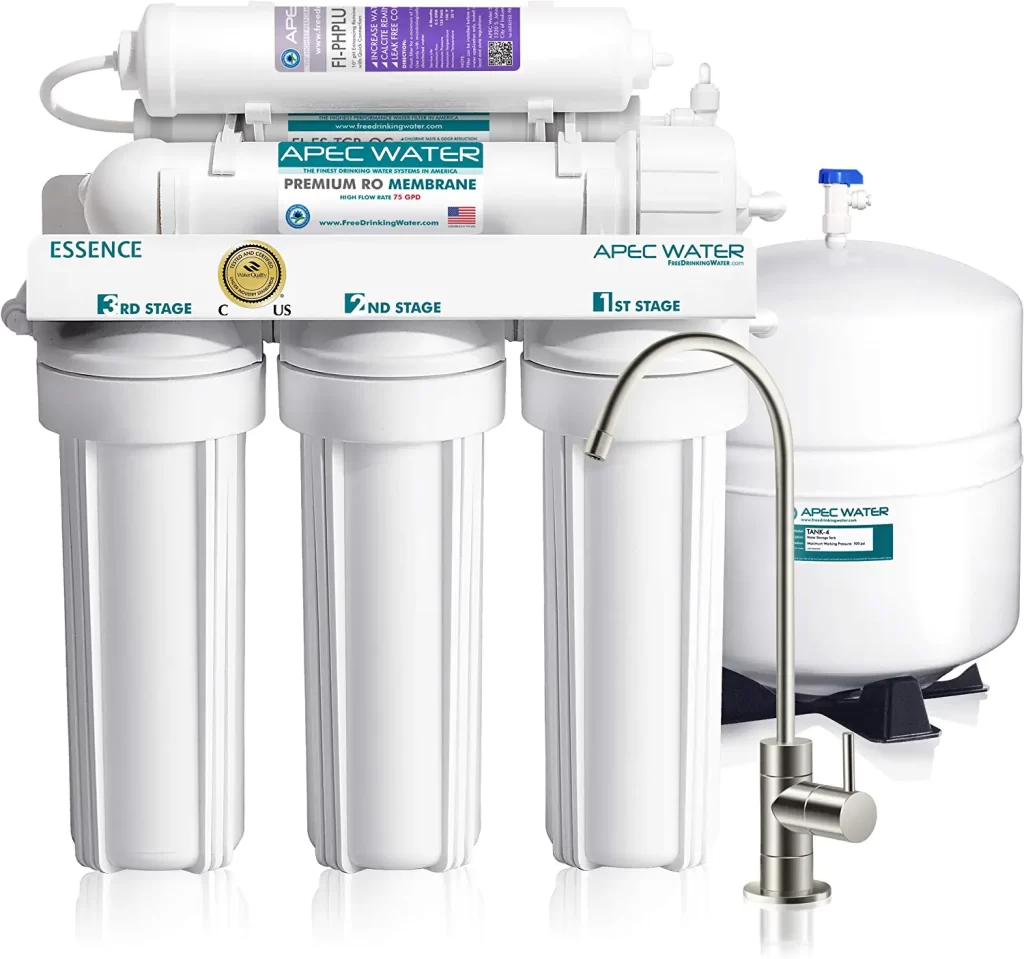
The adapter consists of very sharp edges and you must be a little careful while handling it. This reverse osmosis system follows a six-step purification process during which it consumes around 3 gallons of impure water for every gallon of water it delivers. Most water filters which follow the reverse osmosis process filter out essential minerals from the water. This RO system adds minerals during the filtration process which also helps in improving the flavor of the water.
With a capacity of 4 gallons, the tank stores about 3.2 gallons of filtered water inside it. The rest of the space is occupied by the pressure gladder. For the best output, it is recommended to replace the first three filters after using them for six months. The sixth filter operates like a water neutralizer and contributes calcium carbonate to the water. The filters serve their basic function of providing clean water. They are very effective in battling with a variety of contaminants like chromium, copper, flouride, arsenic and cadmium.
PROS And Cons: APEC ROES-PH75 6-Stage Reverse Osmosis System
7. Express Water UV Reverse Osmosis Water Filtration System
When a water filtration system claims that it shows 99% efficiency when it comes to eliminating contaminants, you know that it does its primary function well. The Express Water filter removes any visible trace of harmful elements like virus, pesticide, lead, flouride and bacteria. That is the single most important reason why it is preferred by so many people who wish to consume hygienic and safe water.
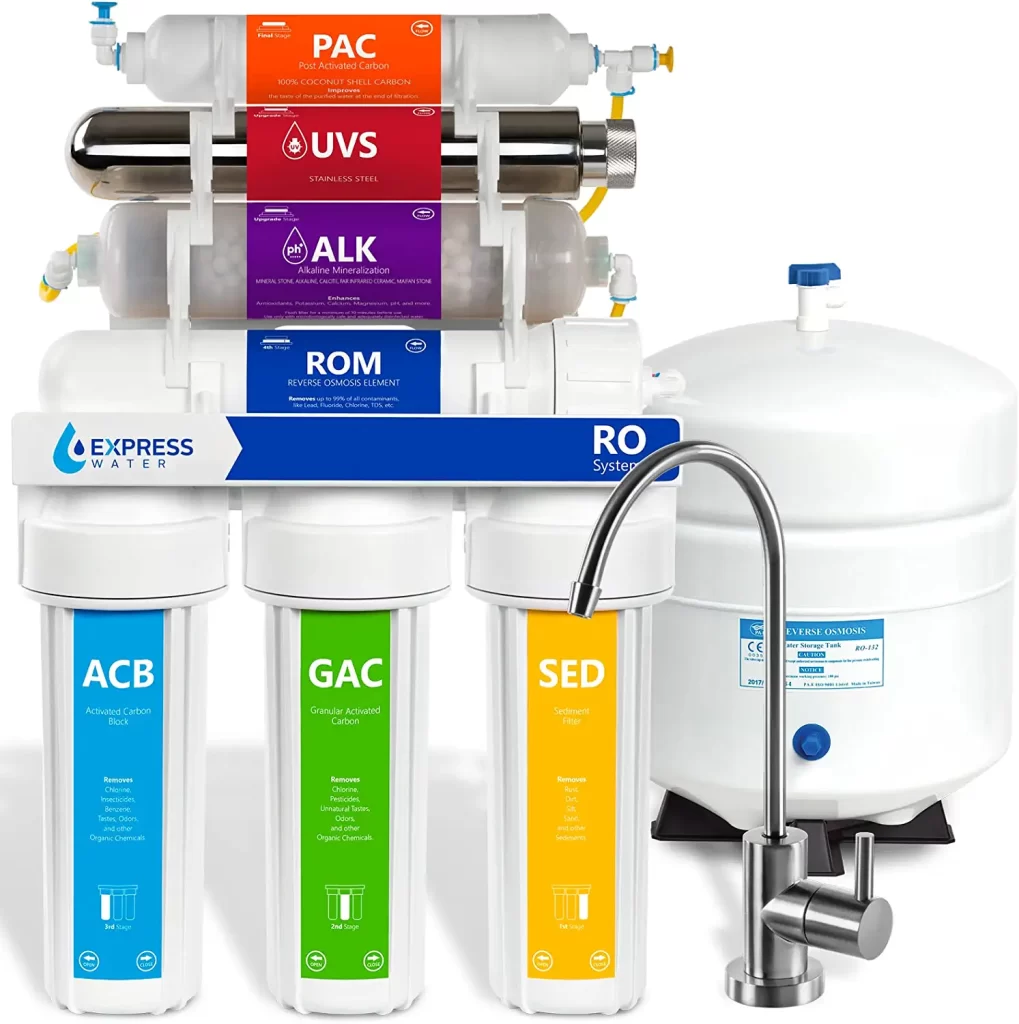
This RO system features an additional filter called the UV sterilizer chamber. This sterilizer chamber plays an important role in the contamination removal process. Water flows through the stainless steel chamber and passes through the UV light which eliminates the contaminants. What makes one further believe in the quality of these filters is the fact that they go through a three-step quality check process – air check test, water pressure test and cycle resistance test.
Depending on the model that you are using, the Express Water filtration system has the capacity to process 50-100 gallons of water every day. The tank has a storage capacity of 4 gallons. The machine uses quick connectors and caps made of different colors to make the process of installation more convenient. Each of the filters has a leak stop detector that stops the process of water flow when it senses the presence of moisture in the atmosphere.
PROS And Cons: Express Water UV Reverse Osmosis
8. Waterdrop RO Water Filtration System
Very few RO systems offer a combination of style and substance. The Waterdrop RO filtration system is one such device. The futuristic design this machine boasts is truly unique and something that would catch your attention almost instantly. While some are not comfortable with the fact that this RO system does not have a storage tank like a traditional filtration device, there are a good number of people who welcome this idea.
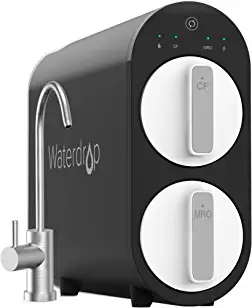
The lack of a storage tank not only leaves you with some extra space in your kitchen area, but also reduces the possibility of bacterial growth in and around the system. The system features three different kinds of filters – CFF filter, RO filter and carbon filter. The three-filter system ensures the elimination of any kind of contaminated substances that could have found their way inside the device.
The filtration system has proved to be 0.0001μm accurate and successfully removes 99 percent of the contaminants present in the water. The carbon block filter helps in improving the taste of the water which can be used for both drinking and cooking purposes. At the faucet, there is an LED display screen that keeps you abreast of the ongoing purification process. There is no hassle or high-end expenses involved in maintaining it. While the installation process is super easy, it takes just about three seconds to change the filters.
PROS And Cons: Waterdrop RO Water Filtration System
9. iSpring RCC7 Reverse Osmosis Filtration System
With a five-step filtration process and the capacity to produce 75 gallons of water, the iSpring RCC7 is an efficient water filtration system that offers good value for money. The device is strongly built and offers a noise-free operation. Even if hardened chemical substances have been accumulated in the filter, it will remove them effortlessly. This water filter never falters when it comes to producing pure water.
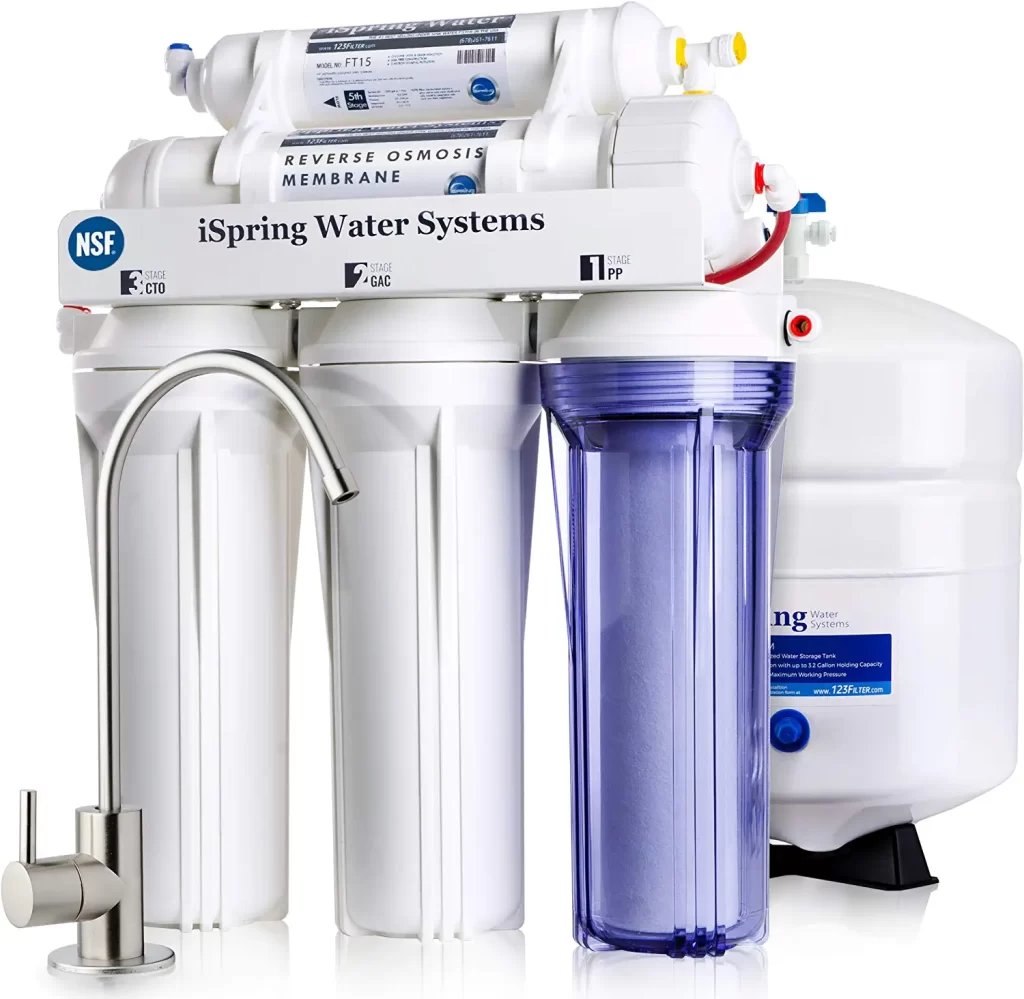
Apart from getting a one-year satisfaction guarantee, a buyer also gets the option to return the product within 30 days of the purchase. The company also provides you with free lifetime support when it comes to technical issues. In the package, you get a well-designed faucet, a Feed Water adapter and a water detector. The RO system needs to be provided with a pressure of 40 to 80 PSI to operate properly. If the water pressure is below 40 PSI, you would require a pump to elevate the pressure. If the pressure is more than the system requires, you can control it with a pressure regulator.
All the components that have been used in building this water filter are of very high quality and that makes it a very reliable device. The multi-layered filtration system is effective at eliminating more than a thousand types of contaminants. What you get towards the end of the filtration process is clean and sanitized water which does not have any trace of any contaminated substance.
PROS And Cons: iSpring RCC7 Reverse Osmosis
10. Whirlpool WHER25 Reverse Osmosis (RO) Filtration System
The Whirlpool WHER25 RO system features extremely well-constructed and durable filters and that is one of the reasons why this device scores very high on performance. It registers a very good ratio of 1:4 when it comes to filtered water to waste water. If you wish to control the waste of water further, you can get a booster pump to elevate the water through the device’s reverse osmosis membrane more quickly. It delivers water that tastes good and is better than bottled water.
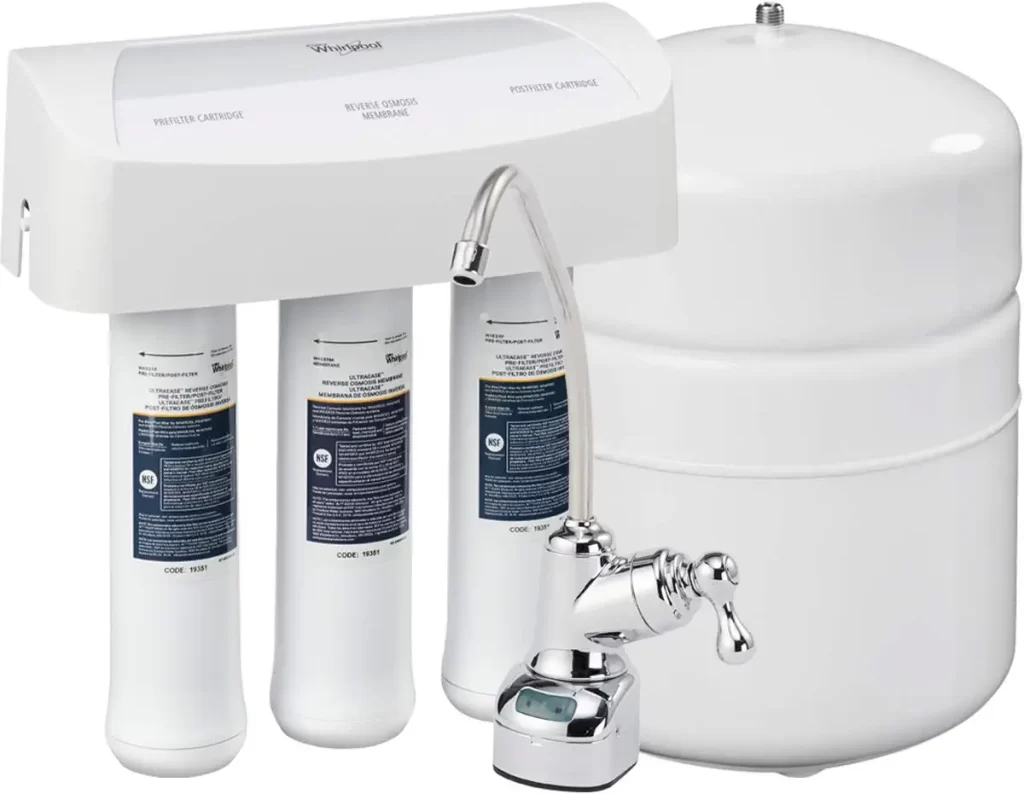
The filtration system has the capacity to produce 18.46 gallons of purified water every day. The reverse osmosis membrane of this device is considerably bigger than regular RO membranes. That is a major reason why it proves to be more effective and efficient in removing contaminants during the RO process. The purified water is preserved in the pressurized storage tank which has a capacity of 3 gallons. The water is very safe to drink as the filtration system reduces the odor and chlorine taste in water and other chemicals, lead, dissolved solids and so on.
As the system has been designed specifically for personal use, it can be installed very easily. If you follow the well laid out instructions in the manual, you would not need the help of a professional to set it up. It is one of those rare filtration systems that come partially assembled and need very little effort to make it fully operational. The push connect fittings and the colored tubings make the process even more easier. It’s also easy to set up due to its compact size.
PROS And Cons: Whirlpool WHER25 Reverse Osmosis
11. AQUATICLIFE RO Buddie Four-Stage Reverse Osmosis System
If you have been looking for a compact filtration system that could be accommodated in a small kitchen area, you could consider buying this one. The AQUATICLIFE RO system is available in two different models. While one is capable of producing 50 gallons of purified water every day, the other offers almost double its production capacity.

The water goes through a three-stage filtration process. Three different kinds of filter cartridges are used to filter the water flowing from the tap. The sediment cartridge is responsible for removing large particles that could clog or obstruct the reverse osmosis system. The Thin-Film Composite membrane along with carbon and sediment filter cartridges help in removing the harmful substances. It is a partially permeable membrane that works towards eliminating particulate contaminants present in the water.
Being a compact device, you can install this filtration system anywhere without facing any difficulty. If there is an aquarium at your place which requires safe and hygienic water, you can position it closer to it. The water filters need pressure ranging from 60 PSI to 100 PSI to function properly.
PROS And Cons: AQUATICLIFE RO
The Benefits of Osmosis Water Filter
Are you tired of buying bottled water? A reverse osmosis system ensures there is quality water in your home fit for your drinking and cooking needs. With the best reverse osmosis system, you can filter out more than a thousand harmful contaminants from your water.
Additionally, you will easily remove foul taste and odor from the water. In this section of the article, we’d like to share with you some of the benefits of using a reverse osmosis system.
Better Taste
As earlier mentioned, a reverse osmosis water system removes debris and chemicals from any water source, which makes it taste better. It’s not magic – it’s as a result of the passage of water through as much as three to seven filtration chambers in a reverse osmosis purifier.
Clean Water
With the best reverse osmosis system, you can remove many harmful aliens from your water. You’ll have rest of mind knowing that you don’t drink contaminated water. The contaminants that are removed by a reverse osmosis system include but are not limited to lead, chlorine, taste, odor, sediment, etc. to mention a few.
Low Energy Usage
Again, a reverse osmosis water system uses less energy when compared to similar water filtration systems. A reverse osmosis machine is ideal if you want to save on energy and still enjoy quality water. However, if you have a reverse osmosis filter installed in many of the faucets in your home, your energy consumption will increase.
At this point, we suggest a faucet water filter which uses no energy at all.
Saves Space
Do you want to buy a reverse osmosis water filter but you are concerned about installation space? Don’t worry, most RO water purifiers are very compact and can fit under your sink. The image below shows the space saving design of a popular reverse osmosis water filter
Low Cost Of Maintenance
Maintaining a reverse osmosis system is as simple as ABC. Generally, a reverse osmosis machine requires a change of the filters at least once in 6 months. You’ll only need to spend on purchasing the filter but not on anything else.
Multi-stage Filtration
The best reverse osmosis system for well water offers up to 7-stages of filtration. Each stage removes different contaminants from your water and improves the quality and taste. The lowest number of stages you should go for is 3. Anything below it won’t be worth spending money.
Saves Cost
Save the money you spend on bottled water with the best reverse osmosis system. Reverse osmosis machine eliminates or lessens the amount you spend on bottled water.
Reduces Plastic Wastes
Water from reverse osmosis water filter is as good as bottled water. Installing Ro water purifier in your home or office reduce the number of plastic waste in the environment. In addition to that, it saves you a lot of money in the long run.
Imagine buying bottled water for a household of 6 or 7 not forgeting the pets!
Easy To Install
You can easily install a reverse osmosis system yourself after reading the instruction manual – no need for professionals. There are also tons of installation videos on YouTube aimed at guiding you in installing your reverse osmosis water system.
Best Reverse Osmosis System Buying Guide:
Now, that you know the benefits of having a reverse osmosis system for home, you need to know the factors to consider before buying one. Read this buying guide thoroughly to make sure you buy a unit that will meet your needs.
The first factor to consider is the cost.
Cost
Here on WaterFilterIQ, we always advocate that you buy what you can afford. However, you shouldn’t sacrifice quality and performance on the altar of price. In the long run, you may end up spending more shipping back defective or low quality products.
Faucet
Most reverse osmosis systems require a separate faucet to dispense the treated water. You can easily change the faucet in your kitchen to a RO faucet without losing the finish, style, and color of your old faucet.
The non-air gap faucet is the common type of RO system faucet. There is a valve inside the non-air gap faucet that prevents the backward flow of water into the reverse osmosis tank.
Stages of filtration
The best reverse osmosis system usually has 3 to 7 stages of filtration. But, your water source will determine the number of filtration stage your RO system should have. Typically, well water and tap water are the most common sources of water.
Treatment plants treat the water they channel to homes. So, tap water logically contains fewer contaminants compared to well water. This is not always so as the water may be contaminated in the pipes.
If you live in an urban area with tap water, an RO water purifier with 3 to 5 stages of filtration should be your base system. Well, water, on the other hand, requires a reverse osmosis system with 6 to 7 stages of filtration since they are known to have high levels of contaminants.
Efficiency
Reverse osmosis machine uses water to clean the reverse osmosis membranes after filtering for a while. RO water purifiers generate wastewater in the course of purifying your water. Most reverse osmosis systems waste up to 4 gallons of water contaminated water for every gallon of purified water.
However, once the Ro system storage tank is filled, the system shuts down. The wasting of water is referred to as pure water to waste water ratio. Opt for the best reverse osmosis system with a low pure water to waste water ratio.
You might want to ask, are there no zero-water-loss reverse osmosis machines?
There are but they re-inject concentrated wastewater into the RO system feeding pipe. The best way to make your reverse osmosis machine more efficient is to connect it to a permeate pump.
Know Your Water Hardness Level
The best RO water purifiers for home does not soften water. So, if your incoming water has a hardness of up to 7 grains per gallon (GPG), consider a softener pre-treatment. This will preserve the life of your reverse osmosis system and membranes.
Installing a whole house water softener is arguably the best solution for this.
Water Pressure
Water pressure is a not-so-important factor that should be considered when buying a reverse osmosis system. The pressure of your water source forces the water through the RO membrane for purification and removal of contaminants.
Many of the RO water systems require a minimum water pressure of 60 psi to work effectively. Most water sources in homes meet this minimum water pressure.
However, if your water source pressure is less than 40 psi, consider buying a Ro system with a booster pump.
Reverse Osmosis System Production Rate
To understand this factor, you need to understand Ro membrane GPD (gallons per day) rating.
Generally, a reverse osmosis system operates efficiently within a pressure range of 40 to 100 psi. Within this pressure range, a reverse osmosis system generates 10 to 75 gallons (45 to 340 liters of water) per day.
Note that cold water cuts the production rate of RO systems by half. In addition to that, GPD ratings are issued to reverse osmosis systems under specific conditions – contaminants, temperature, and water.
We recommend an RO system with a GPD rating between 50 to 70. One gallon per hour with a water source pressure of 60 psi, therefore, a 50 GPD rating will serve a whole house adequately.
Filter Replacement
Buy an RO system with easy to replace filters. Don’t forget to check for the price of the filters before you buy the reverse osmosis unit. If you intend to buy replacement filter, buy only half a dozen or a pack of four.
We don’t advise buying in bulk since filters are only changed once or twice yearly. Filter manufacturers can produce better filters within that period of time.
Quality Certifications
Buy a reverse osmosis system with the best quality certifications. Again, check for the number of certifications –WQA (water quality association) and safety – TDS (total dissolved solids) reduction.
Pre-Filters, Carbon Blocks, And Sediment Filter
To get the value of your money, buy a reverse osmosis machine with three pre-filters, one sediment, and two carbon blocks.
Here’s why!
Pre-filters, positioned above the RO membrane filters sand, and large deposits from the water source. Carbon blocks filter chlorine, odor and taste pollutants. Also, it prevents the RO system from wearing early due to chlorine.
Sometimes sediment pre-filters (which are cheaper than carbon) replace the second carbon block after the RO membrane. There is nothing wrong in that but, don’t buy a reverse osmosis system with two sediment pre-filters since carbon blocks filter contaminants better than sediment filters.
FAQ About Reverse Osmosis (RO Water Purifier)

Below we tried to answer the most common questions about using and managing a reverse osmosis system.
Q. What Is A Reverse Osmosis Filtering System?
A. Reverse osmosis (RO) is a filtration process which uses pressure to force water through a semi-permeable membrane. Osmosis occurs naturally in nature, but, this machine reverses the process of osmosis using energy. The RO membrane holds solute (solid) on one side and allows pure solvents (liquid) pass through to the other side.
Normally, osmosis is the movement of liquid from a region of low solute concentration, to a region of high solute concentration, without applying pressure, through a semi-permeable membrane. The reverse osmosis system does the exact opposite.
RO membranes consist of a thin polyamide layer (<200nm) on a polyethersulfone or polysulfone porous layer (50 microns) over a non-woven fabric sheet for support. This water purifier applies a pressure greater than the osmotic pressure to successfully reverse osmosis and purify water.
The semi-permeable membrane allows water to pass through it, but, retain solid particles. The membrane has a dense layer where separation occurs (the non-woven fabric).
Q. How Does A Reverse Osmosis System Work?
A. The water source flows through a sediment pre-filter placed above the RO membrane. It removes dirt and small particles in the water which flow to a carbon pre-filter. Also, the two carbon pre-filters filter organic contaminants: chlorine, taste and odor pollutants.
Next, the pre-filtered water enters the reverse osmosis semi-permeable membrane.
This membrane has a tight sheet-like filter which only allows water through whilst holding back dissolved solids, sodium, and contaminants like:
- Lead
- Arsenic
- Asbestos
- Calcium etc.
A reverse osmosis water system cleans its membrane with some of the water that passed through it. The contaminated water flows into kitchen drainpipes while the purified water collects in a storage tank until when needed.
This stored water is given a final push when you open the faucet by a post-carbon filter. The purified water in the tank is forced out of the tank by air pressure and goes through the second carbon filter. Assuredly, this final filter gives reverse osmosis water its taste and quality.
This description is for a 4-stage reverse osmosis machine. A 7-stage reverse osmosis system has other essential parts such as a flow control device, check valves and an automatic shutoff device.
Watch this video to understand how a Ro system works.https://web.archive.org/web/20210127000914if_/https://www.youtube.com/embed/aVdWqbpbv_Y
Q. What is the Best Reverse Osmosis System for Drinking Water?
A. Importantly, all reverse osmosis system membranes produce purified water, though they differ in features and sizes. The best RO water purifier for drinking water would depend on your water source. As we earlier mentioned, a 5-stage RO system works best with tap water. But, for well-water, you would need a 6 or 7-stage reverse osmosis machine
Q. RO Water Efficiency Ratio, Permeate Pump and an Air Gap Faucet Explained
A. Reverse osmosis system efficiency is the ratio of wasted water and pure water. A reverse osmosis machine with a ratio of 4:1 or lesser is considered efficient.
On the other hand, a reverse osmosis permeate pump is a simple device that utilizes the energy from the RO system wastewater to push pure water into the storage tank. A permeate pump isolates the tank from the Ro membrane, which acts as an atmospheric tank.
An air gap faucet creates a siphon break between itself, the Ro system, and the sink drain. Simply, the air gap system allows water to drop from one tube through the air, into another tube. So, when a sink drain is blocked, the air gap faucet pulls air instead of dirty water into the reverse osmosis system.
Pretty confusing, isn’t it? It’s not, really.
Q. What does Reverse Osmosis Remove from Water?
A. The best reverse osmosis system filters up to 1000 contaminants (particles and impurities) from different water sources such as:
- Lead
- Chlorine
- Fluoride
- Arsenic
- Hormones
- Asbestos
- Sodium
- Calcium
- Bacteria
- Virus
- Chloramines
However, reverse osmosis system like the iSpring RCC7 6-Stage comes with a mineralization filter that restores healthy minerals. Some reverse osmosis systems also change the alkalinity of the water.
Q. How Pure is Reverse Osmosis Water?
A. A reverse osmosis system water is as pure as bottled water. Carbon filters in RO systems remove volatile chemicals, chloramines, etc.
Q. Is Reverse Osmosis Water bad for you?
A. No, reverse osmosis water is not bad for you, rather it’s very healthy for you as its free from contaminants and harmful microorganisms. Furthermore, it is good for pets – so they too can have access to clean water.
Q. Is Reverse Osmosis Water good for Plants?
A. Yes. If you decide to water your plants with reverse osmosis water, please go ahead.
Q. How To Install A Reverse Osmosis System?
A. Some reverse osmosis system must be installed by a licensed plumber while others come with an installation guide for you to install it yourself. Here is a list of the installation procedure:
- Install the faucet on your sink.
- Mount the faucet with someone holding it above the sink.
- Install the angle valve and tubing right under the sink.
- Fasten the valve with a drain saddle.
- Install the RO components.
- Install the RO unit.
- Pre-fill the storage tank with water to check for leaks.
- Connect the final tubing.
- Start-up the system.
Find a more detailed explanation of a reverse osmosis system installation in the video below.https://web.archive.org/web/20210127000914if_/https://www.youtube.com/embed/FAii8mJUM6k
Q. How to Maintain a Reverse Osmosis Water System?
A. The pre and post filters of a reverse osmosis system must be changed regularly, at least after 6 months of usage. It is important to note that the frequency of changing the filter is dependent on the type of RO system and the level of contamination in the water.
Q. How to Change The Filters In Your Reverse Osmosis Water Filter?
A. This instruction is for a standard Ro system, ensure proper sanitation when changing your Ro drinking water filters and membranes. Follow this steps to replace your Ro system filters:
- Turn off the water valve
- Close the valve on the reverse osmosis system and the refrigerator or ice maker
- Release pressure in the system by opening the faucet
- Place a tray the sink to avoid spillage
- Unscrew and remove the old filter
- Remove the O-rings and
- Place the new filter in the filter housing and tighten with your hand only.
Conclusion
The best reverse osmosis systems technology is one of the most modern and effective ways to purify water. Discussed above are some of the most popular reverse osmosis water filtration systems available in the market today. As you can see, they come in different shapes, sizes and features as well. Once you figure out your requirements, you have to analyze the features of all these water filtration systems and pick the one that best suits your needs. While trying to extract purified water, you must ensure that the system you are using does not deprive you of the essential minerals that are required for healthy living.
There’s no reason not to drink clean water. Use this best reverse osmosis system review and buying guide to select a reverse osmosis machine that suits your home and your needs.